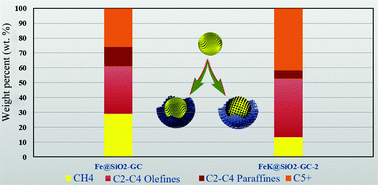Potassium promoted core–shell-structured FeK@SiO2-GC catalysts used for Fischer–Tropsch synthesis to olefins without further reduction
Abstract
Fe-based Fischer–Tropsch synthesis (FTS) catalysts, promoted by graphitic carbon (GC) and potassium, were directly prepared by a novel modified sol–gel method without further reduction. The effects of the GC promoter and K contents on the catalyst structures and FTS performance were systematically studied. The significant improvement of FTS performance was attributed to GC, which acted as a reductant for synthesizing metallic Fe0 from Fe3+ in the chelating complexes, and effectively enhanced the strength of SiO2 channels. Meanwhile, an appropriate amount of K ions promoted CO chemisorption and inhibited H2 chemisorption by affecting the electronic properties of iron, resulting in a lower hydrogenation capacity and a higher olefin selectivity. Transmission electron microscopy and CO-TPD characterization proved that FeK@SiO2-GC catalysts had well-defined core–shell structures and higher CO chemisorption. The FTS results indicated that the introduction of a small amount of GC and K (K/Fe/GC, 1.5/100/100) improved the reduction and dispersion of iron during the calcination process, and significantly enhanced the FTS activity. The CO conversion and C2–C4 olefin selectivity of the catalyst increased rapidly from 21.1% and 23.7% to 53.5% and 41.3% after GC and K promotion. The GC and K promoted Fe-based catalysts prepared by a modified sol–gel method, which omits the complex and high energy consumption reduction process, can be used directly for highly efficient FTS and thus will be more promising in the future.



 Please wait while we load your content...
Please wait while we load your content...